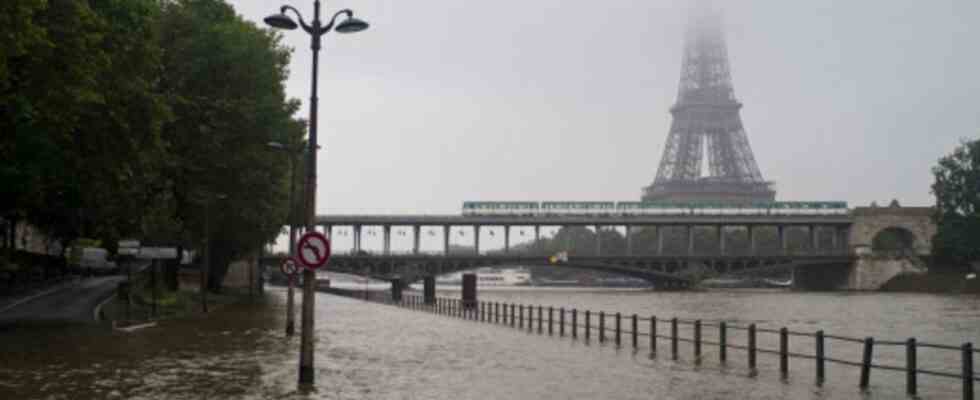After the heat wave, the deluge. If Paris and Ile-de-France were not part of the eight territories placed in orange storm vigilance on Tuesday, lightning still struck the capital, accompanied by driving rain. “It fell the equivalent of a month of precipitation in forty minutes”, summarizes 20 minutes Marta Torre Schaub, CNRS research director at ISJPS at Paris-1 University. Specifically, more than 40 millimeters of rain fell in the space of 90 minutes. A downpour that surprised the inhabitants, especially in the metro where real waterfalls poured, like here at the Balard station on line 8.
The Paris metro is designed to withstand heavy rain and is equipped with a system of pumps sometimes “capable of emptying an Olympic swimming pool in a few minutes” and which makes it possible to regulate the consequences of the rain in the capital, explains a SNCF driver on Twitter. However, this system does not seem adapted to the torrential precipitations like those of Tuesday evening. Those that rain cubic meters of water equivalent to a month’s rain without warning, in a few minutes. Traffic has indeed been severely disrupted on the Ile-de-France network, with several stations closed.
A Parisian or urban problem?
And this is not a problem that only concerns Paris. “The more the city is urbanized, the more we will encounter this kind of flooding,” explains Marta Torre-Schaub. “We planned a type of urban planning that was not planned for this kind of consequences of climate change, we ignored the fact that it could happen, we ignored the various IPCC reports [Groupe d’experts intergouvernemental sur l’évolution du climat], is moved the director of research. So we continued to build our cities as if this kind of major bad weather was not going to happen to us”.
Thus, outside the capital, near Marseille, at Cassis, a torrent of rain also poured into the city. Images that echo other photos taken elsewhere on the planet, such as during the floods in New York in 2021, or in the Chinese city of Zhengzhou the same year. More recently, in the summer of 2022, Seoul, South Korea was marked by severe flooding, as was Doha, the capital of Qatar.
Climate change being global, no one is now spared. “Thirty years ago, we saw it in remote territories, in the Pacific Islands, and now the consequences are spreading everywhere,” says Marta Torre-Schaub. This concerns floods as well as other extreme events producing disasters, such as fires, which this year in France have already ravaged more than 60,000 hectares.
A predictable episode?
Was it possible to predict this rainy episode and take measures ahead of the flood? It’s always easier to criticize once the storm has passed. However, if this kind of episode surprises by its violence and its unpredictability, the weeks and weeks of heat waves as well as the very worrying state of the water tables in France, could have steered some public officials. “We have known for a long time that each time we have very strong heat waves, the soil dries out and can no longer absorb, so when heavy rains fall, there is a greater risk of flooding” , develops Marta Torre-Schaub. This type of risk is mentioned in The report returned last April to Ademe (the Ecological Transition Agency), of which our research director is the author.
Paris is nevertheless a “pioneer” in terms of adaptation to climate change. A file of the City thus reports on the risks incurred in the face of floods which will be more violent and more frequent in the future. It offers some solutions to protect the inhabitants: “The Paris flood risk prevention plan (PPRI) requires managers of establishments with a public service mission to draw up a flood protection plan (PPCI) when these establishments are located in a flood zone in Paris. This plan must be updated annually and describes the measures taken to deal with an exceptional flood, as well as the period of return to normal after the flood”.
The risks of fires, storms and heat waves are also discussed. These adaptation plans are essential when we understand that these episodes will repeat themselves and become practically annual in about thirty years.
How to adapt to change?
Progress clearly remains to be made and lessons can be learned from the impressive images broadcast on social networks on Tuesday evening. Perhaps “better protect certain stations” more exposed to the risk of flooding, suggests Marta Torre-Schaub. She points out, for example, that in certain parts of the 16th arrondissement, “the ground is completely impermeable, so as soon as it rains a lot, rivers are created over several meters with a significant depth”. More broadly, “we must make urban adaptation plans and not just in Paris”, says the research director.
“Removing the concrete, creating islands of freshness, planting trees, rethinking the pavement, investing in more suitable materials…”, are all ideas that can inspire city mayors to prevent the risks associated with climate change. . But Marta Torre-Schaub concedes: “It’s more complicated for cities like Paris, Lyon, Bordeaux, which have a particular urban history”. Nevertheless, rethinking our cities becomes urgent “because the longer we delay, the more it will cost and the more we will have to make sacrifices to adapt”, she continues. In the end, to save money, it is better to spend immediately without waiting for it to be too late, because the climate emergency is there.

